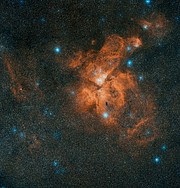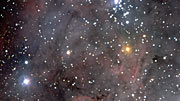Press Release
Strong Winds over the Keel
Carina Nebula shown in colourful detail
12 February 2009
The latest ESO image reveals amazing detail in the intricate structures of one of the largest and brightest nebulae in the sky, the Carina Nebula (NGC 3372), where strong winds and powerful radiation from an armada of massive stars are creating havoc in the large cloud of dust and gas from which the stars were born.
The large and beautiful image displays the full variety of this impressive skyscape, spattered with clusters of young stars, large nebulae of dust and gas, dust pillars, globules, and adorned by one of the Universe's most impressive binary stars. It was produced by combining exposures through six different filters from the Wide Field Imager (WFI), attached to the 2.2 m ESO/MPG telescope at ESO's La Silla Observatory, in Chile.
The Carina Nebula is located about 7500 light-years away in the constellation of the same name (Carina; the Keel). Spanning about 100 light-years, it is four times larger than the famous Orion Nebula and far brighter. It is an intensive star-forming region with dark lanes of cool dust splitting up the glowing nebula gas that surrounds its many clusters of stars.
The glow of the Carina Nebula comes mainly from hot hydrogen basking in the strong radiation of monster baby stars. The interaction between the hydrogen and the ultraviolet light results in its characteristic red and purple colour. The immense nebula contains over a dozen stars with at least 50 to 100 times the mass of our Sun. Such stars have a very short lifespan, a few million years at most, the blink of an eye compared with the Sun's expected lifetime of ten billion years.
One of the Universe's most impressive stars, Eta Carinae, is found in the nebula. It is one of the most massive stars in our Milky Way, over 100 times the mass of the Sun and about four million times brighter, making it the most luminous star known. Eta Carinae is highly unstable, and prone to violent outbursts, most notably the false supernova event in 1842. For just a few years, Eta Carinae became the second brightest star in the night sky and produced almost as much visible light as a supernova explosion (the usual death throes of a massive star), but it survived. Eta Carinae is also thought to have a hot companion that orbits around it in 5.54 years, in an elliptical orbit. Both stars have strong winds, which collide, leading to interesting phenomena. In mid-January 2009, the companion was at its closest distance to Eta Carinae. This event, which may provide a unique insight into the wind structure of the massive stars, has been followed by a flotilla of instruments on several of ESO's telescopes.
Contacts
Henri Boffin
ESO
Garching, Germany
Tel: +49 89 3200 6222
Email: hboffin@eso.org
Valentina Rodriguez
ESO
Chile
Tel: +56 2 463 3123
Email: vrodrigu@eso.org
About the Release
| Release No.: | eso0905 |
| Legacy ID: | PR 05/09 |
| Name: | Carina Nebula, NGC 3372 |
| Type: | Milky Way : Star : Grouping : Cluster : Open Milky Way : Nebula |
| Facility: | MPG/ESO 2.2-metre telescope |
| Instruments: | WFI |




